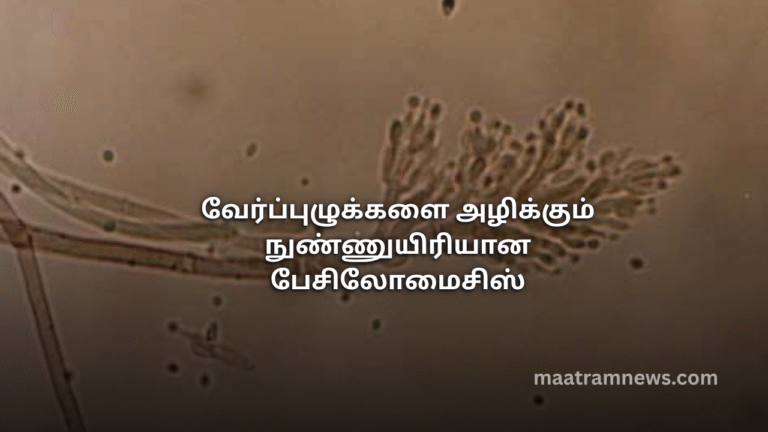வேர்ப்புழுக்களை அழிக்கும் நுண்ணுயிரியான பேசிலோமைசிஸ்
ஓர் வகைப் பூஞ்சண நுண்ணுயிரியான இது மண்ணில் உள்ள வேர்ப்புழுக்கள் (Nematodes) பயிரைத் தாக்காதவாறு பாதுகாக்கின்றது.
இப் பூஞ்சண நுண்ணுயிரி, நூற்புழுக்களின் முட்டை முதல் அனைத்து பருவங்களையும் தாக்கி அழிக்கின்றது. இறந்த வேர்ப்புழுக்கள் மீது பூஞ்சணம் நன்றாக வளர்ந்து மேலும் அதிக வேர்ப்புழுக்களைத் தாக்கி அழிக்கிறது.
வேர்ப்புழுக்கள் பயிர்களின் வேரை அரிப்பதினால் , வேர் மற்றும் கிழங்கு அழுகல் நோயை உண்டாக்கக் கூடிய பூஞ்சணங்கள் மிகவும் எளிதாக பயிர்களைத் தாக்க ஏதுவாகின்றது.
வேர்ப்புழுக்களை அழிப்பதால் மறைமுகமாக வாடல், மற்றும் வேர் அழுகல் நோய்களில் இருந்து பயிருக்கு பாதுகாப்பு அளிக்கிறது.
இப் பேசிலோமைசினால் சுரக்கப்படும் நொதிகள் வேர்ப்புழுக்களின் முட்டை ஓட்டில் உள்ள கைட்டின் மற்றும் பிற புரதங்களைச் சிதைத்து முட்டைகளையும் அழிக்கிறது.
பயன்படுத்தும் முறை மற்றும் அளவு
ஒரு ஏக்கருக்கு 2L திரவத்தை, 100 Kg தொடக்கம் 1000 Kg சேதன உரத்துடன் கலந்து, 3 நாட்கள் நிழலான இடத்தில் மூடிவைத்து வயலில் / தோட்டத்தில் இடவும்.
பசளையிடப்பட்ட நிலமாயின் 16 லீ தாங்கிக்கு 300 மில்லி திரவத்தை கலந்து பயிரின் வேர் மண்டலத்துக்கு நன்கு தெளிக்கவும். (மாலை வேளைகளில் பிரயோகிப்பது மிகுந்த பலனளிக்கும்.)
இலங்கையில் இவற்றின் பயன்பாடு
கடந்த சில வருடங்களாக நுவரெலிய, கற்பிட்டி மற்றும் சிலாபம் பகுதிகளில் ஏற்றுமதிக்கென விளைவிக்கப்படும் நஞ்சற்ற கிழங்கு மற்றும் மரக்கறிகளுக்கு வேர்ப்புழுக்கள் கட்டுப்பாட்டுக்கென வெற்றிகரமாக பயன்படுத்தப்படுகின்றன.
அம்பாந்தோட்டை மாவட்டத்தில் வாழை பயிரிடும் இயற்கை விவசாயிகள், கடந்த ஒரு சில வருடங்களாக இவற்றை பயன்படுத்தி வருவது குறிப்பிடத்தக்கது.
வட மாகாண இயற்கை விவசாயிகள், அண்மைக்காலமாக மரக்கறி, வெங்காயம் மற்றும் வாழைப்பயிர்ச்செய்கையில் இவற்றை பரவலாக பயன்படுத்திவருகின்றமையினை அறியமுடிகிறது.
வன்னி மற்றும் கிழக்கிலும் அண்மைக்காலமாக சில இயற்கை விவசாயிகள் நெற்செய்கையில் இவற்றைப் பிரயோகிப்பதாக அறியமுடிகிறது.
புத்தளம், அனுராதபுரம் மாவட்ட கொய்யா விவசாயிகள் அண்மைகாலமாக இவற்றைக் கொண்டு நெமற்றோட்ஸ்களை அறியமுடிகிறது.
வேர்ப்புழுக்கள் பயிர்களைத்தாக்கும் முறைகள்
- தன் தலைப்பகுதியில் உள்ள ஊசி போன்ற அமைப்பினால் நேரடியாக வெளிப்புறமாக வேரை துளையிட்டு சத்துக்களை உறிஞ்சல்.
- வேரினுள் ஊடுருவி முட்டை இட்டு வேர் முடிச்சு போன்ற அமைப்பினை ஏற்படுத்தி அதனூடாக பிற தீமை செய்யும் நுண்ணுயிரிகளின் தாக்குதலுக்கு வழிகோலுதல்.
வேர் புழுக்களின் தாக்குதலை எவ்வாறு இனம்காண்பது?
- செடிகளின் உயரம், பருமன் குறைந்து காணப்படும்.
- செடிகளில் பக்கக் கிளைகள் குறைவாக இருத்தல்.
- செடியைப் பிடுங்கி வேரினைப் பரிசோதிக்கும் போது வேரில் காயங்கள் அல்லது சிறு முடிச்சுக்கள் போன்ற அமைப்புக்கள் வேரில் காணப்படும். (அவரை இன தாவரங்களில் வரும் முடிச்சுக்கள் அல்ல)
- பக்க வேர்கள் குறைந்து வேர்கள் கட்டையாக தடித்துக் காணப்படும்.
- போதிய நீர் இருப்பினும் பயிர் செழிப்பின்றி, பச்சையம் குறைந்து வளர்ச்சி குன்றி காணப்படும்.
- வேர்கள் வெடித்து காணப்படல்.
- இலையின் நுனி வெள்ளை அல்லது சிவப்பாக மாறியிருக்கும்.
இயற்கைமுறையில் தடுக்கும் படிமுறைகள்
- பயிர் சுழற்சி செய்தல்.
- பேசிலோமைசிஸ் எனும் நஞ்சற்ற நுண்ணுயிரி உரத்தினைப் பயன்படுத்திக் கட்டுப்படுத்தல்.
மேலதிக விபரங்கள்
CSJ Agri
076 225 0017
மேலதிக தகவல்களுக்கு மாற்றம் செய்திகள் இணையத்தளத்தினுள் பிரவேசியுங்கள்.
மேலதிக தகவல்களை உடனுக்குடன் பெற்றுக்கொள்ள மாற்றம் செய்திகள் முகநூல் பக்கத்தை பின்தொடரவும்.
Basillomyces – A Beneficial Fungus that Destroys Root-Knot Nematodes
Basillomyces is a type of beneficial fungus found in the soil that protects crops from root-knot nematodes (Nematodes).
This fungal microorganism attacks and destroys nematodes at all stages of their life cycle — from eggs to adults. After killing the nematodes, it grows on their dead bodies and continues to attack more nematodes in the soil.
Since nematodes damage plant roots, they make crops more vulnerable to root and tuber rot diseases caused by other fungi.
By eliminating nematodes, Basillomyces indirectly protects plants from wilt and root rot diseases.
The enzymes secreted by Basillomyces dissolve chitin and other proteins in the nematode egg shells, destroying the eggs effectively.
Application Method and Dosage
- For one acre, mix 2 liters of Basillomyces liquid with 100–1000 kg of organic manure, cover, and keep it in a shaded area for 3 days. Then apply it to the field or garden.
- If the land is already manured, mix 300 ml of Basillomyces liquid in a 16-liter sprayer tank, and apply it near the root zone of the plants.
(Application during the evening hours gives the best results.)
Usage in Sri Lanka
1️⃣ Over the past few years, farmers in Nuwara Eliya, Kalpitiya, and Chilaw have successfully used Basillomyces to control nematodes in pesticide-free yams and vegetables grown for export.
2️⃣ Banana farmers in Hambantota District who practice organic farming have been using it effectively for several years.
3️⃣ In the Northern Province, organic farmers have widely adopted it in vegetable, onion, and banana cultivation.
4️⃣ In Vanni and Eastern Provinces, some organic farmers have recently begun using it in paddy cultivation.
5️⃣ Guava farmers in Puttalam and Anuradhapura districts are also reported to be using Basillomyces for nematode control.
How Nematodes Attack Crops
- They pierce the outer root tissue using a needle-like structure in their head to suck nutrients.
- They enter roots, lay eggs, and form knot-like swellings (root galls), allowing other harmful microbes to attack.
Symptoms of Nematode Infestation
- Plants appear stunted with reduced height and thickness.
- Fewer side branches are seen.
- When uprooted, roots show small galls or wounds (not the nodules seen in leguminous plants).
- Lateral roots are reduced, and roots appear thickened and deformed.
- Despite adequate water, plants look weak, pale, and stunted.
- Roots may appear cracked.
- Leaf tips turn white or reddish.
Natural Control Methods
- Practice crop rotation.
- Apply Basillomyces-based organic bio-fertilizer regularly to suppress nematode activity.
For More Information
CSJ Agri
📞 076 225 0017



